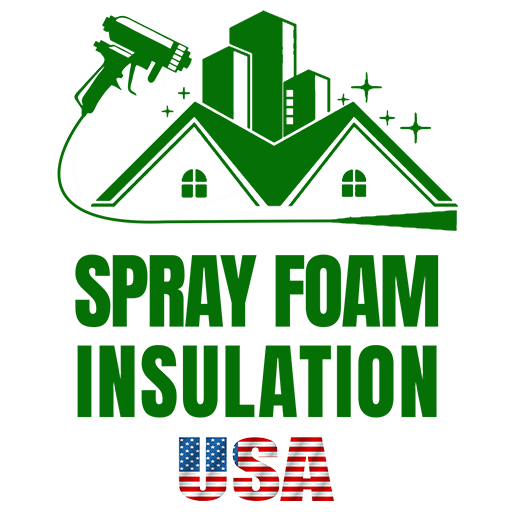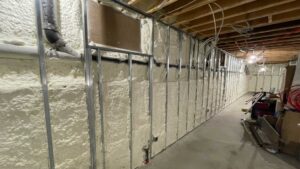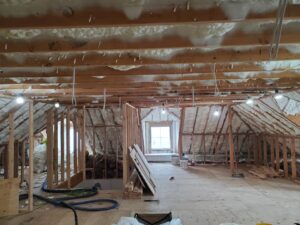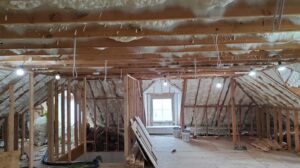Quick Guide to Foam Insulation:
- Fast Answer: Foam insulation, especially Spray Polyurethane Foam (SPF), is your go-to for lowering bills, stopping drafts, and protecting against moisture.
- Why It Matters: Proper insulation keeps your home or workplace comfortable, slashes energy costs, and is a green choice for the planet.
- Where to Use: Perfect for attics, crawlspaces, existing homes needing a boost in insulation, commercial spaces, and more.
Why Foam Insulation Matters for You:
If you live or work in NY or NJ, you know the sting of high energy bills and the discomfort of drafty spaces all too well. Insulation isn’t just about staying warm or cool; it’s about creating a more energy-efficient, comfortable, and sustainable environment. This is where foam insulation comes into play, particularly Spray Polyurethane Foam (SPF). SPF isn’t just any insulation. It’s a champion in sealing leaks, preventing drafts, and saving on those ever-rising energy bills.
Whether you’re a homeowner looking to make your living space cozy year-round or a business owner aiming to make your workplace more energy-efficient and comfortable for your employees, foam insulation provides a solution. By choosing spray foam, you are not only enhancing the comfort and efficiency of your space but also contributing to a greener planet by reducing energy consumption.
Let’s dive into why foam insulation is your best bet for protecting against air leakage, moisture, and high energy bills, and how selecting the right insulation solution can make all the difference in your home or commercial setting.

Understanding Foam Insulation
When we talk about foam insulation, we’re diving into a world that’s both wide and deep, filled with options that cater to various needs. At the heart of this world lies polyurethane foam, a standout choice for many homeowners and businesses. Let’s break down what you need to know, keeping it simple and straight to the point.
Types of Foam Insulation
There are mainly two types:
– Open-Cell Foam: Think of it like a sponge. It’s softer, more flexible, and allows water and air to move through it. Great for soundproofing but not the best at blocking water.
– Closed-Cell Foam: This is the tough guy. It’s denser, stronger, and acts as a barrier to water and air. It’s like putting a superhero shield around your house.
Polyurethane Foam
This is where the magic happens. Polyurethane foam can be either open-cell or closed-cell. It’s made by mixing two materials that react and expand. This expansion fills gaps and cracks, creating an airtight seal. It’s like custom-making a sweater for your house that fits perfectly into every nook and cranny.
Benefits
Here’s why people love it:
– Energy Efficiency: It keeps your home cozy in winter and cool in summer, reducing the need for heating and cooling.
– Comfort: Say goodbye to drafts and cold spots. It’s like living in a constant hug.
– Moisture Protection: Especially with closed-cell foam, it helps keep your home dry and mold-free.
Thermal Performance
This is all about keeping the temperature inside your home just right. Foam insulation does this really well because it fills up spaces completely, leaving no room for air to sneak in or out. It’s like closing all the doors and windows tightly on a stormy day.
R-value
Remember this term because it’s important. The R-value measures how well insulation can resist heat flow. The higher the R-value, the better it is at keeping heat in (or out). Polyurethane foam has a high R-value, making it a top-notch choice for keeping your home energy efficient.
Understanding foam insulation is the first step in choosing the right solution for your home or business. With its excellent thermal performance, high R-value, and the ability to create an airtight seal, polyurethane foam stands out as a superior choice. Whether you’re looking to enhance comfort, improve energy efficiency, or protect against moisture, there’s a foam insulation solution that fits your needs.
Installation Process
Choosing the right insulation is just the start. Next comes the installation, which can make or break your insulation’s effectiveness. Let’s dive into what you need to know.
DIY Considerations
Thinking of installing foam insulation by yourself? It’s crucial to weigh the pros and cons. Here’s a quick rundown:
- Safety First: Foam insulation chemicals can be harmful. You’ll need protective gear like goggles, gloves, and a respirator.
- Equipment: A professional-grade kit is a must. This includes foam, hoses, and a spray gun.
- Preparation: The area must be clean, dry, and free of debris. You’ll also need to mask off areas to avoid unwanted spray.
- Application: Even coverage and proper foam expansion are key. This requires a steady hand and an eye for detail.
While DIY can save money upfront, the risk of incorrect installation could lead to higher costs down the line.
Professional Installation
For most, hiring professionals like Spray Foam Insulation USA is the safer, more efficient route. Here’s why:
- Expertise: Professionals bring years of experience. They know exactly how to handle the foam, ensuring it reaches all nooks and crannies.
- Efficiency: A professional team can complete the job quickly, minimizing disruption to your home or business.
- Safety: They come equipped with the right safety gear and know how to handle the materials safely, protecting you and your property.
- Peace of Mind: Knowing the job is done right can save you from future headaches, like inefficiencies or the need for reinstallation.
Spray Foam Insulation USA
Choosing Spray Foam Insulation USA means opting for a hassle-free installation process. Here’s what sets them apart:
- Customized Solutions: They evaluate your space to recommend the best foam insulation solution, tailored to your specific needs.
- Energy Efficiency: Their expert installation creates a tight barrier, reducing heat loss and minimizing outside air infiltration.
- Quality Service: From the initial assessment to the final inspection, their focus is on delivering quality and satisfaction.
Whether you’re tempted to DIY or leaning towards professional installation, consider the long-term benefits and peace of mind that come with hiring experts like Spray Foam Insulation USA. They not only ensure a seamless installation but also help enhance your property’s comfort, energy efficiency, and overall value.
Moving on, let’s address some common concerns and solutions related to foam insulation, ensuring you’re fully informed before making a decision.
Common Concerns and Solutions
When considering a foam insulation solution for your home or commercial property, it’s natural to have concerns. Here, we’ll tackle some of the most common issues, including downsides, off-gassing, cleanup, and the use of solvents like acetone and DPM (Dipropylene Glycol Monomethyl Ether). By understanding these aspects, you can make a more informed choice about foam insulation.
Downsides
While foam insulation offers numerous benefits like energy efficiency and soundproofing, there are a few downsides to consider:
- Cost: Initially, foam insulation can be more expensive than traditional insulation materials. However, the long-term savings on energy bills can offset this.
- Installation Sensitivity: Proper installation by professionals is crucial. Incorrect application can lead to gaps or overuse, diminishing effectiveness.
Off-gassing
One concern often raised about foam insulation is off-gassing, where newly applied foam releases chemicals into the air. This is primarily a concern during and immediately after installation. Choosing products with lower volatile organic compounds (VOCs) and ensuring your space is well-ventilated during installation can mitigate this issue. Once fully cured, foam insulation is considered non-toxic.
Cleanup
Cleanup after installation can seem daunting due to the sticky and quick-setting nature of foam insulation. Here’s where professional installation becomes invaluable. Professionals like those from Spray Foam Insulation USA are equipped with the right tools and knowledge for quick and efficient cleanup, ensuring minimal disruption to your space.
Solvents: Acetone and DPM
In cases where foam insulation needs to be removed or cleaned up after an accidental spill, solvents such as acetone and DPM can be used. Acetone is effective for uncured foam, easily dissolving it. However, use it in a well-ventilated area and follow safety guidelines to avoid irritation or health risks.
DPM is a gentler alternative, useful for cleaning surfaces or tools affected by foam insulation. It’s less volatile than acetone, offering a safer option for sensitive environments.
By addressing these common concerns with practical solutions and precautions, homeowners and contractors can maximize the benefits of foam insulation while minimizing potential drawbacks. Always remember, the expertise and experience of professional installers play a crucial role in ensuring the success and longevity of your insulation project, making it a worthwhile investment for the comfort and efficiency of your space.
Moving forward, we’ll dive into some frequently asked questions about foam insulation to further clarify any uncertainties you might have.
Frequently Asked Questions about Foam Insulation
When it comes to foam insulation, many folks have questions. Let’s tackle some of the most common ones to help you make informed decisions about your foam insulation solution.
Can I spray foam insulation myself?
Yes, you can! But, it’s not as simple as it might seem. Spraying foam insulation requires careful preparation, the right equipment, and a keen eye for detail. You’ll need to wear protective gear and follow the instructions closely. While many homeowners successfully take on DIY spray foam insulation projects, it’s important to understand the process fully before diving in. Safety first!
What is the downside to foam insulation?
While foam insulation offers a boatload of benefits like high energy efficiency and excellent air sealing, there are a few points to consider:
– Upfront Cost: Initially, foam insulation can be pricier than traditional materials. However, the energy savings over time usually offset this.
– Application Precision: Incorrect application can lead to gaps or uneven coverage, which impacts performance. It’s crucial to get it right the first time.
– Chemical Safety: The installation process involves chemicals, so ensuring proper ventilation and using protective gear is a must to safeguard your health and indoor air quality.
Is there anything that will dissolve spray foam insulation?
Once cured, spray foam insulation is designed to be incredibly durable and resistant to breakdown. However, if you need to remove or clean up uncured spray foam, solvents like acetone or dimethyl sulfoxide (DMSO) can be effective. It’s important to follow safety guidelines when using these chemicals and to test them in a small, inconspicuous area first to avoid damaging surfaces.
As we’ve explored these common questions, it’s clear that while DIY spray foam insulation is achievable, it requires careful planning and consideration. The benefits of foam insulation are significant, from enhancing your home’s energy efficiency to improving comfort. However, understanding the potential downsides and how to address them ensures you’re prepared for a successful installation.
Choosing the right foam insulation solution involves weighing factors like eco-friendliness, energy efficiency, and specific needs such as soundproofing or waterproofing. With the right approach, foam insulation can be a game-changer for your home or commercial space.
In the next section, we’ll dive deeper into choosing the right foam insulation solution, considering factors like sustainability and specific benefits tailored to your needs.
Choosing the Right Foam Insulation Solution
When it comes to insulating your space, whether it’s your home or a commercial building, not all foam insulation solutions are created equal. The right choice can significantly impact your comfort, energy bills, and even the planet. Let’s explore how to pick the foam insulation that fits your needs, focusing on eco-friendliness, energy efficiency, soundproofing, waterproofing, and overall sustainability.
Eco-friendly Options
It’s no secret that we all need to do our part for the environment. When selecting a foam insulation solution, consider products made from recycled materials or those with a lower environmental impact. For instance, certain types of spray foam insulation are made with water or soy as blowing agents, which have a smaller carbon footprint compared to traditional materials. Opting for these eco-friendly options not only helps reduce your home’s energy consumption but also supports a healthier planet.
Energy Efficiency
The primary role of insulation is to keep your space warm in the winter and cool in the summer, all while reducing energy costs. Spray foam insulation is a powerhouse in this department. Its ability to create an air-tight seal means minimal heat escape, leading to significant energy savings. When choosing a foam insulation solution, look for products with high R-values—a measure of thermal resistance. The higher the R-value, the better the material insulates.
Sound Proofing
Noise pollution can be a big problem, especially in busy urban areas or for buildings close to highways. Foam insulation can act as an effective sound barrier, absorbing sounds to reduce the transmission of noise from outside to inside. If soundproofing is a priority for you, consider closed-cell spray foam, which offers superior noise reduction capabilities compared to other insulation types.
Waterproofing
Moisture can be the enemy of any building, leading to mold, mildew, and structural damage. Fortunately, certain foam insulation solutions offer excellent waterproofing properties. Closed-cell foam insulation, for instance, is not only great for thermal insulation but also prevents water infiltration. This makes it an ideal choice for areas prone to moisture, such as basements, bathrooms, and kitchens.
Sustainability
Lastly, sustainability should be a key consideration. Beyond the material’s immediate environmental impact, think about its longevity and performance over time. Durable, high-quality foam insulation can last for decades, making it a more sustainable option in the long run. Additionally, insulation that maintains its efficiency over time means less energy consumption and, consequently, a lower carbon footprint for your home or building.
Choosing the right foam insulation solution involves weighing these factors to find a product that aligns with your values and meets your specific needs. Whether you’re most concerned about energy efficiency, soundproofing, or environmental impact, there’s a foam insulation solution out there for you. Investing in the right insulation pays off in the long run through reduced energy bills, increased comfort, and the peace of mind that comes with making a sustainable choice.
In our next section, we’ll wrap up with a look towards the future of insulation and how Spray Foam Insulation USA is leading the way. Stay tuned for insights on the latest trends and innovations in the insulation industry.
Conclusion
As we close this definitive guide, it’s clear that the future of insulation lies in sustainable, energy-efficient solutions that not only protect our homes but also our planet. At Spray Foam Insulation USA, we’re at the forefront of this exciting future, committed to providing top-tier foam insulation solutions that meet the needs of today and tomorrow.
The Future of Insulation
The insulation industry is rapidly evolving, with a strong emphasis on materials that are not only effective but also environmentally friendly. Spray foam insulation is leading the charge, thanks to its incredible ability to seal homes from air and moisture infiltration, save on costly utility bills, and significantly reduce energy consumption. As we look ahead, we anticipate even greater innovations in spray foam technology, including advancements in eco-friendly formulations and application techniques. These developments promise to make foam insulation an even more compelling choice for homeowners and businesses alike.
Spray Foam Insulation USA: Paving the Way
At Spray Foam Insulation USA, we’re more than just a service provider; we’re pioneers in the insulation industry. Our commitment to sustainability and energy efficiency drives us to constantly seek out and embrace the latest advancements in foam insulation solutions. We understand the importance of not just insulating spaces but doing so in a way that contributes to a healthier environment for future generations.
- Customized Solutions: We know that every home and business is unique, which is why we offer tailored insulation solutions designed to meet specific needs and budgets.
- Expertise and Innovation: Our team stays on the cutting edge of insulation technology, ensuring that we’re always offering the most advanced and effective products available.
- Sustainability at Heart: We’re dedicated to reducing our carbon footprint and helping our customers do the same, making us a trusted partner in the journey toward a greener world.
In conclusion, the path to a more sustainable and energy-efficient future is clear, and it’s paved with the innovative foam insulation solutions offered by Spray Foam Insulation USA. As we continue to push the boundaries of what’s possible in insulation technology, we invite you to join us in making a lasting, positive impact on the environment and on your energy bills.
Ready to embrace the future of insulation with a solution that’s as kind to the planet as it is to your wallet? Discover the advantages of choosing Spray Foam Insulation USA for your insulation needs.
Together, let’s build a greener, more sustainable world, one insulated space at a time.





